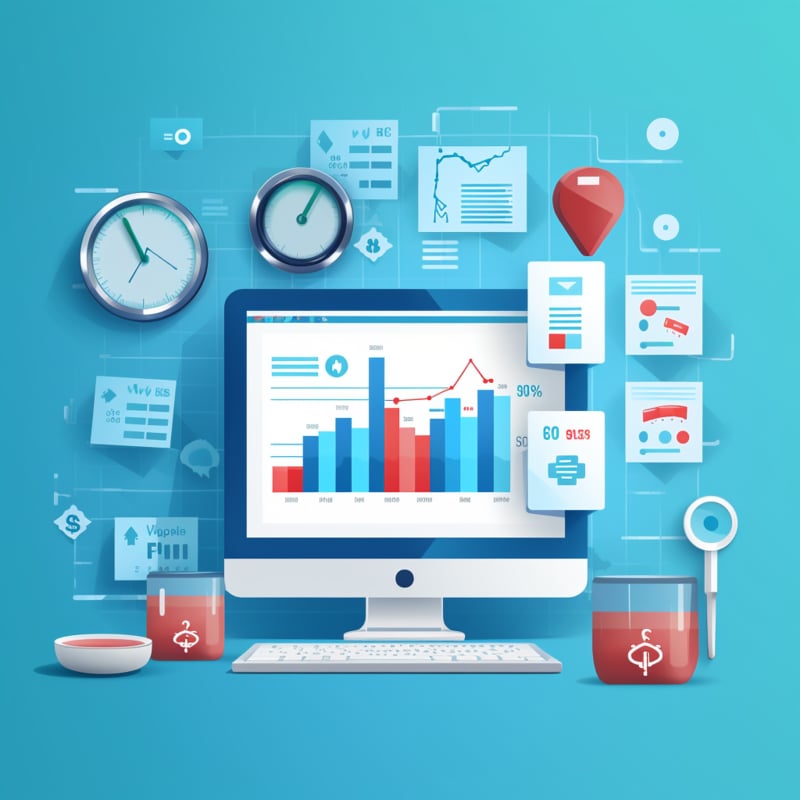FHIR Tutorial | What is FHIR in Healthcare?
At this HL7 FHIR tutorial blog, we’ll help you master its fundamentals. FHIR, an emerging healthcare data interchange standard designed to facilitate interoperability and accessibility among health information systems, will serve as your guide throughout.
FHIR, developed by Health Level Seven International (HL7), has revolutionized healthcare data sharing and use by making collaboration simpler among providers, patients and stakeholders.
This FHIR HL7 tutorial for beginners will introduce FHIR’s concepts and its impact on healthcare delivery systems. Perfect for healthcare professionals, software developers, or those curious about emerging healthcare technology.
This course can help learner’s comprehend FHIR and how its role contributes to shaping tomorrow’s healthcare systems!
So let’s discover FHIR together!
What is FHIR,or What is HL7 FHIR?
FHIR stands for Fast Healthcare Interoperability Resources, which is essential for enabling HR systems to communicate with external devices like mobile apps and desktop applications. FHIR aims to provide a more efficient and user-friendly solution for the healthcare industry by addressing these issues.
The term “fast” refers to the convenience of using the latest technologies in healthcare interoperability, such as Rest APIs, for implementing resources and transferring data between different applications.
FHIR, which comes in four flavours or paradigms, is designed to facilitate the exchange of healthcare data in the form of resources.
The main intention behind FHIR is to leverage the latest technologies, whether bright on FHIR, rest, or authorisation. FHIR has made special efforts to make the standard more humane, making it easily read and freely available.
As healthcare continues to move towards using the latest technologies, FHIR is becoming a favourite among implementers and suggests designing architectures and multiple paradigms for common scenarios.
The course on FHIR is a recent addition to the IoT industry aimed at digital healthcare. It began in 2010 and has evolved significantly since then. We will also cover the basics of FHIR, including its evolution from version two to its current implementation.

The introduction discusses the purpose of FHIR in the healthcare industry, its problem-solving capabilities, and use case scenarios. FHIR provides various resources, including patient resources, rest services, and bundle resources. These resources coordinate and work in sync to provide a comprehensive solution.
The focus is on understanding patent resources, their structure, icons, and data types. Rest services exchange data between different systems, and FHIR defines various interaction models for data exchange. It also covers how to create and update patient records using rest services.
The architecture of the FHIR Facade
The architecture of the FHIR Facade is based on anFHIR repository or endpoint, with requests coming in with services.
The service layer is where the service can consume and respond to FHIR endpoints. The process layer orchestrates business rules and handles translations from inbound formats to downstream systems. The backend system connection is the operation of converting the response to internal formats.
The FHIR facade architecture simplifies FHIR, enabling an existing application by eliminating the need for custom code.
Three primary benefits of the FHIR facade architecture include out-of-the-box interoperability, translation tools, and an internal data model. These features allow for seamless integration with existing applications and data sets, ensuring efficient and effective FHIR enabling.
FHIR Extensions
FHIR extensions are a way to add missing data elements from the base specification, which is designed to be less complex and more easily implemented. The FHIR extension mechanism requires that when creating an extension, the definition is published to a publicly accessible server, allowing anyone receiving data with that extension to understand its meaning.
What is FHIR API?
The first paradigm is Rest API, which focuses on how to exchange data with a purpose. The industry and community drive this standard, but other sites exist, such as documents, which can be exchanged, developed interfaces, and replaced V2 messaging with Re messaging. Additionally, services can create or replace V2 messaging with Re messaging.
Finally, after completing all FHIR-related tasks, transactions can be achieved using resources. This includes generating a proper resource or message, creating computable solutions, and ensuring that resources are available for quick validation.
FHIR Resources
A resource instance is a highly focused data that gathers data elements together. It is different from a form, which is an empty template. When saving data to the FHIR repository, many resource instances are created as the data is filled in and dedicated to the database.
Resource FHIR refers to the organisation of data in the healthcare industry, with each brick representing a small unit of information that makes sense. For example, a patient’s registration information can be combined into one resource, such as their name, date, gender, and assistant.
Resources often use old standards, such as segmenting and correlating to one resource. For example, a form in a hospital may contain patient information, insurance information, and other forms. When separated, these forms form separate highly focused data sets, which can be considered one resource.
These resources form one meaningful data set, providing valuable clinical information. For example, a patient’s order information might not provide enough information for a significant clinical record. However, when combined with other forms, such as an insurance form, it gives a virtual form of meaningful information.

FHIR Training

The company supports various languages, including JavaScript, Python, C++, object script, embedded Python, and language gateways. These gateways provide full access to the FHIR repository and all the same code as if the code were running on the server.
The solution to this problem is the FHIR facade solution, which allows resources to be saved into a database. This will enable users to create, update, or delete resources, but it is important to note that resources do not always stay in the database separately.
More on resource existence will be discussed, including resource instances and references. Organisations can better manage and utilise their resources by understanding the importance of resources in the healthcare industry.
A patient resource is expressed in a JSON structure, which can be exchanged in various formats. The current window displays four sections of data: base, domain, and resource. The bottom section contains patient information such as name, family, given name, phone number, gender, and birth date.
Specifications of FHIR
The FHIR specification website provides a comprehensive resource section with various views, including category, alphabet, art, and more. The categorised view categorises resources into functional, clinical, financial, and special categories. Base resources help manage administration aspects, while practitioner, organisation, encounter, and appointment resources are admin-related.
To understand the concepts around a resource, focus on the patient resource and its details. All data elements are involved in the patient resource section, such as identifier, name, telecom, and gender. These elements are called elements in HL7 and are organised into fields like identifier, name, telecom, and gender.

The FHIR specification website also includes a sample external structure and sample data structure. These three formats allow data to be stored and managed in FHIR.
Transferring information from the EHR database to a separate FHIR serverwould allow for developing a full-flow GHR application. Enterprise hospitals may prefer a different on-premise data set, ensuring compliance with government rules and regulations.
This could be achieved by having a separate FHIR repository with all resources in the form of FHIR resources and their own EHR.
EHRs don’t need to be online or 24/7; hospitals must handle exposure data 24/7. In such cases, a separate FHIR repository on a cloud could be used but still have its own data set in the form of EHR.
Use cases of FHIR
The platform is also used by government entities such as the Veterans Administration and the Social Security Administration. Inter-systems’ philosophy is to build a standard set of resources that satisfy most use cases regarding interoperability and data exchange across healthcare and globally. This allows organisations to speak a common language, such as payers and providers with different systems and data sets.
Use cases of using FHIR in healthcare clinical applications. There are three paradigms for building successful partner applications built on FHIR technology:
1) Making on top of anFHIR repository, which can be used with any FHIR repository on top of a clinical data set, enabling a standard development model where users can choose their technology and language.
2) Making an existing application FHIR-enabled by writing translations or anFHIR facade on top of the data can be practical for limited subsets of FHIR capability.
3) Integrating FHIR with formats like HL7 FHIR or CCD documents.
Inter System Platform
Inter Systems platform, Iris for Health, is a multi-cloud platform that allows developers to develop applications for real-time use cases. The platform features data management, an interoperability toolkit, and an analytical layer that helps make sense of data stored in FHIR.
FHIR is a complex healthcare format that combines transaction-based and summary-based data formats. It is a JSON-based format with resources, which are individual tidbits of data related to a patient, climate show, visit, or observation.
Inter Systems platform offers a high-touch model and prebuilt support for data management, scale, interoperability, and analytics at scale.
The first significant application paradigm is building an application on a FHIR repository, which automatically supports modern healthcare formats like S2, 3, R4, and R5, as well as customisations. This allows for easy interoperation with modern EMRs, which have FHIR-first capabilities.
Inter Systems offers a pre-built FHIR repository, allowing developers to set up and interact with the data without building or doing Java. Web development capabilities and standard APIs, including an embedded Python runtime, make sense of this data.
Inter Systems has a high-touch sales engineering model, with highly qualified engineers working closely with customers and partners. They have a world-class support organisation, which operates in rarefied air regarding customer satisfaction.
Inter Systems has a 24-by-seven multi-lingual support organisation, with many of the engineers themselves answering phone inquiries.

FHIR Online Training

Inter-Systems offers freedom of choice for developers, with JavaScript, slash node, Win, and other languages available. The FHIR Experience Layer allows FHIR interactions with the core system, while the FHIR Facade provides flexibility in managing and mapping internal data.
There are also external Python gateways, C sharp, node JS, R gateways, and a Go language gateway in development.
Process of Integrating Patient Data into the EHR System
Integrating patient data into electronic health records (EHR) involves several steps. First, demographic data is sent from PM2HR to the EHR system, followed by appointment scheduling and doctor consultations.
After an encounter, doctors order tests like blood or thyroid tests, which are then sent to the lab for analysis. The results are then sent back to the Health Records (HR) system, where doctors review the results and provide prescriptions or procedures based on the diagnosis.
Charge information is generated from the lab and HR systems, and the data is sent back to the receptionist for claim submission.
Additional aspects such as allergies, medications, and daily vitals are also involved in the inpatient workflow. In the emergency department, the data sets need to be understood in real-time scenarios. Organisations have tried to provide patient portals to address this issue but have not fully managed it.
FHIR has been introduced as a solution by adding a FHIR facade layer to the EHR system. This layer exposes internal data to the outside world as JSON objects, known as resources. This allows external developers to develop mobile or desktop apps to access patient data and will enable them to access their information within the EHR.
The increasing demand for data and the need for patients to access their clinical history has led to implementingFHIR.
Data exposure in the healthcare industry is a significant problem, and various solutions have been developed to address this issue. One solution is to add a FHIR layer to expose data to the outside world, allowing other developers to create mobile app solutions.
Another solution is to create a FHIR repository, which stores all the data in the EHR database in a separate repository, such as a relational or non-relational database. A FHIR layer executes transactions to transfer data in JSON or XML, allowing patients to access the data.
The advantages of this solution include the constant availability of databases and network standards, which are essential for mobile apps to interact with the data sets. Hospitals often prefer moving data to anFHIR repository, such as on the cloud like Azure or AWS, which takes care of security and exposes the data to the outside world.
Types of FHIR Solutions
There are two main types of FHIR solutions: server-side and client-side.
Server-side solutions involve developing anFHIR layer, receiving data in the form of JSON, validating it, cleaning it up, and executing transactions. Most implementations fall under one of these categories.
The need for FHIR in healthcare is due to the increasing interoperability standards and the need for real-time data access by most systems.
FHIR is a new standard in healthcare that aims to enhance patient engagement, mobile app interaction, and healthcare data exchange.

Client-side is based on previous standards such as H11 V2, H11 V3, and H11 C D A. FHIR uses the latest technology of REST APH for data transacting between mobile client applications and other clients with the FHIR server. Resources are the primary key in FHIR, and everything revolves around resources.
Critical Concepts of FHIR
Two key concepts in understanding FHIR areFHIR resources (uniform resource locators) and FHIR profiles (customisation of FHIR resources for specific use cases).
FHIR resources have a known location on the internet and a defined meaning, while FHIR profiles are customised for specific use cases.
Interoperability in FHIR comes from systems using the same FHIR profile for a particular use case, defining the meaning of the data for that use case.
Data expressed according to a particular FHIR profile can be exchanged in different interoperability paradigms. For example, a lab test result can be defined according to anFHIR profile, which can be used in decision support or a CDA document without transforming it.
This is part of the power of FHIR, as it allows for different interoperability paradigms without changing the data.

FHIR Course Price


Ankita
Author